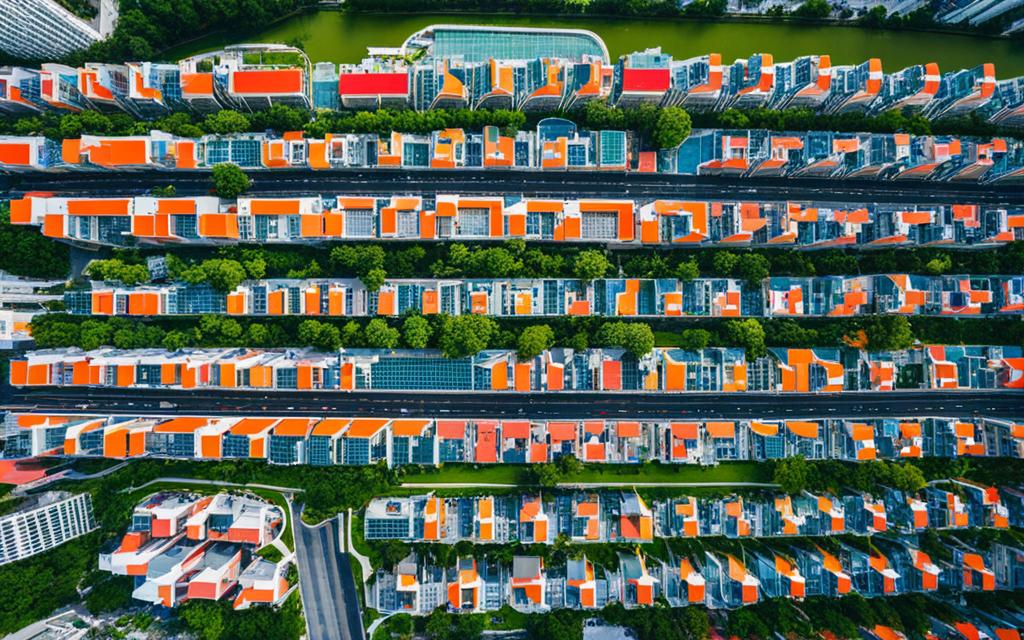
As investors and stakeholders closely monitor the singapore property market analysis, key findings reveal an upward trajectory poised for continual expansion. The current real estate trends in singapore suggest a dynamic residential real estate landscape, estimated to burgeon from USD 46.58 billion in 2024 to USD 64.04 billion by 2029, reflecting a robust compounded annual growth rate (CAGR) of 6.57%. This promising property market forecast is propelled not only by a demand surge in logistics and industrial space but also by a significant interest in affordable housing developments.
With an eye on the future, discerning investors are tuning into housing market statistics, which underscore Singapore as a hotspot for premium real estate ventures. The remarkable strides by conglomerates like Frasers Logistics & Commercial Trust and Sinarmas Land, underscore the city-state’s growing reputation as a lucrative canvas for property investment analysis. As Singapore cements its status as an emerging tech hub, spurred by government initiatives and a bustling tourism sector, the real estate market beckons with untapped potential and burgeoning opportunities for global investors.
The Overview of Singapore’s Real Estate Landscape
Delving into the Singapore property market updates reveals a transformative phase experienced within this dynamic environment. Concrete housing market research underpins the city’s reputation as a continuously flourishing hub for property investments. With a distinctively low market concentration, the real estate landscape nourishes a fertile ground for both international investors and prominent domestic firms such as City Developments Limited and GuocoLand Limited.
The allure of Singapore’s commercial real estate scene is particularly compelling, promising stable returns driven by the revival of prime retail spaces. Focused real estate market analysis also points towards an ascension in prime retail rentals, especially around the bustling Orchard Road retail belt, suggesting a post-pandemic boom complemented by the renewal of public gatherings and holiday celebrations.
- Emergence of prime locations as central to investment strategies
- Indications of recovery in the retail segment with increased year-over-year rentals
- Industrial growth, particularly in new warehouse developments in the western precincts
Investor sentiment within the Singapore property market remains buoyant, with keen interest in prime country locales for new real estate ventures. This enthusiasm is anchored by Singapore property insights, charting out a landscape poised for ongoing expansion in commercial and residential domains.

Consequently, investors captivated by the evolving tapestry of the Singapore housing market are met with a robust and synergistic matrix of opportunities reflecting the current and future trajectory of this vibrant city-state’s property sector.
Key Factors Influencing Property Values in Singapore
As one delves into the nuances of the property market forecast, a confluence of elements becomes visible that steers the course of real estate trends in Singapore. Influences ranging from legislative frameworks to economic vitality compose the mosaic of factors impacting property investment analysis. Here, we dissect the pivotal ingredients that mold the landscape of property values within the thriving island nation.

Impact of Government Regulations and Policies
Government regulations and initiatives are not mere spectators in the arena of Singapore’s housing market. They are, instead, strategic chess pieces that influence both the ebb and flow of residential and commercial spaces. Public housing policies, specifically, have a storied presence, offering affordable options and setting standards that ripple across the property sector.
Economic Growth and Its Effect on Property Demand
In the relay race of economic progress, sectors such as hospitality and technology have handed Singapore a baton of growth. Business travel stimulates hotel real estate, catering to a cosmopolitan clientele. On a parallel track, Singapore’s burgeoning reputation as a tech oasis draws a high volume of office space demand, contributing significantly to property economics.
Interest Rate Trends and Their Influence on Real Estate Investments
The pulse of the property market, often monitored by the heartbeat of interest rates, resonates through the investment decisions within commercial real estate. In the climate of historically low rates, commercial assets gleam with attractiveness, offering equitable returns and loan affordability—fundamental variables investors diligently assess.
- Regulatory measures fostering public-private cooperation in housing initiatives.
- Economic advancement influencing business tourism and tech sector expansion.
- Interest rate fluctuations sculpting the appeal and viability of real estate assets.
This triad of factors collaboratively dictates the real estate investment analysis, guiding stakeholders through the nuanced corridors of Singapore’s property market forecast.
Singapore Property Market Analysis: A Forecast into 2029
As Singapore strides towards the next decade, the property market forecast outlines an optimistic landscape for the industry. Fueled by strategic development and strong economic fundamentals, the projected growth appears nothing short of bright. The fusion of international capital with local expertise has engendered a property ecosystem that’s both vibrant and robust, mirroring the calculated expansion anticipated by market analysts.
With deep dives into the housing market statistics, it becomes apparent that Singapore stands at the cusp of a real estate renaissance, poised to attract a flurry of investment across varying sectors. The trajectory suggests a blend of innovation, with sustainable and affordable housing solutions steering the market, seamlessly integrating with luxury and industrial real estate developments.
- Anticipated growth with the market size potentially reaching USD 64.04 billion by 2029.
- Projected CAGR of 6.57%, indicating healthy market momentum.
- Continued interest in prime locations and investment hotspots.
- Sustained demand in the affordable housing sector.
- Ongoing development in industrial and commercial real estate projects.
Given the importance of staying ahead in a fluctuating market, Singapore property market analysis will serve as the lighthouse for those navigating these investment waters. Stakeholders are recommended to keep an analytical eye on both macroeconomic indicators and niche market movements to harness the full potential of Singapore’s property landscape.

Indeed, the coming years promise to unfold as a chapter of dynamic growth for the Singapore property market. It’s a narrative that beckons savvy investors and policymakers alike to play a part in sculpting a future where the skyline is a testament to prudent foresight and pro-active investment strategies.
Assessing the Residential Real Estate Segment
The landscape of the residential real estate market in Singapore continues to be dynamic and robust, underpinned by the introduction of compelling new developments and a strong foundation of resilient housing schemes. An in-depth scrutiny of this sector not only reveals emerging real estate trends in Singapore but also provides a wealth of information pertinent to a comprehensive property investment analysis. As we delve deeper into this vital segment, let’s explore the various elements that signify its current state and future prospects.
New Developments Shaping the Housing Market
Recent years have witnessed transformative projects, including The Continuum, Grand Dunman, and Tembusu Grand within the Rest of Central Region (RCR), significantly energizing the housing market. These auspicious ventures have been notable contributors to the vitality of the segment, offsetting the potential headwinds caused by gradual increases in interest rates. With these eminent constructions at the forefront, the housing market statistics relay a message of prevailing investor confidence and sustainability of growth in this sphere.
Current Housing Market Statistics and What They Indicate
Market indicators from 2023 have surfaced with some intriguing insights. A nearly 59% upsurge in sub-sale transactions suggests a shift in investor behavior, potentially in anticipation of further escalation in home loan rates. Additionally, the observed 12% uptick in the average price per square foot, with the RCR leading at a considerable 18.14% increase, mirrors the buoyancy imparted by these new additions to Singapore’s skyline. This tangible growth corresponds with earnest Singapore property insights, underlining the market’s flexible and adaptive nature.
Resilience of the Affordable Housing Projects
Amidst market changes, affordable housing projects have displayed remarkable resilience, maintaining their appeal and demand. This segment’s endurance is a critical component of the property market forecast, as it assures continued interest and stable investment opportunities. Even with stringent fiscal regulations like the Additional Buyer’s Stamp Duty (ABSD), particularly impacting overseas investors, premium residential developments such as LEEDON GREEN and PULLMAN RESIDENCES NEWTON in the Core Central Region (CCR) have sustained their sales momentum. This unwavering resilience accentuates the strong fundamentals of Singapore’s residential real estate segment, projecting a promising trajectory for future investments.

